Article's Content
The marketing funnel is not dead, despite what some experts might say.
I know there are people who claim to have found new ways that make the funnel obsolete, but the funnel is still very much alive and well, even for the SaaS industry. Asana’s $5 million SEO moat success is solid proof.
The $5 billion project management software company has over 131,000 paying customers and millions of free users from organizations in 190 countries. Big companies like Amazon, Japan Airlines, and Affirm trust the tool to manage company goals, digital transformations, product launches, and marketing campaigns.
Aside from launching useful features, Asana focuses on creating top-of-the-funnel (TOFU) content to attract, educate, and build trust with potential users.
The result?
6 million organic visits each month and 8 million+ backlinks from high-authority sites like Calendly, Eventbrite, NY Times, and HubSpot.
Here’s what its organic search scorecard looks like:
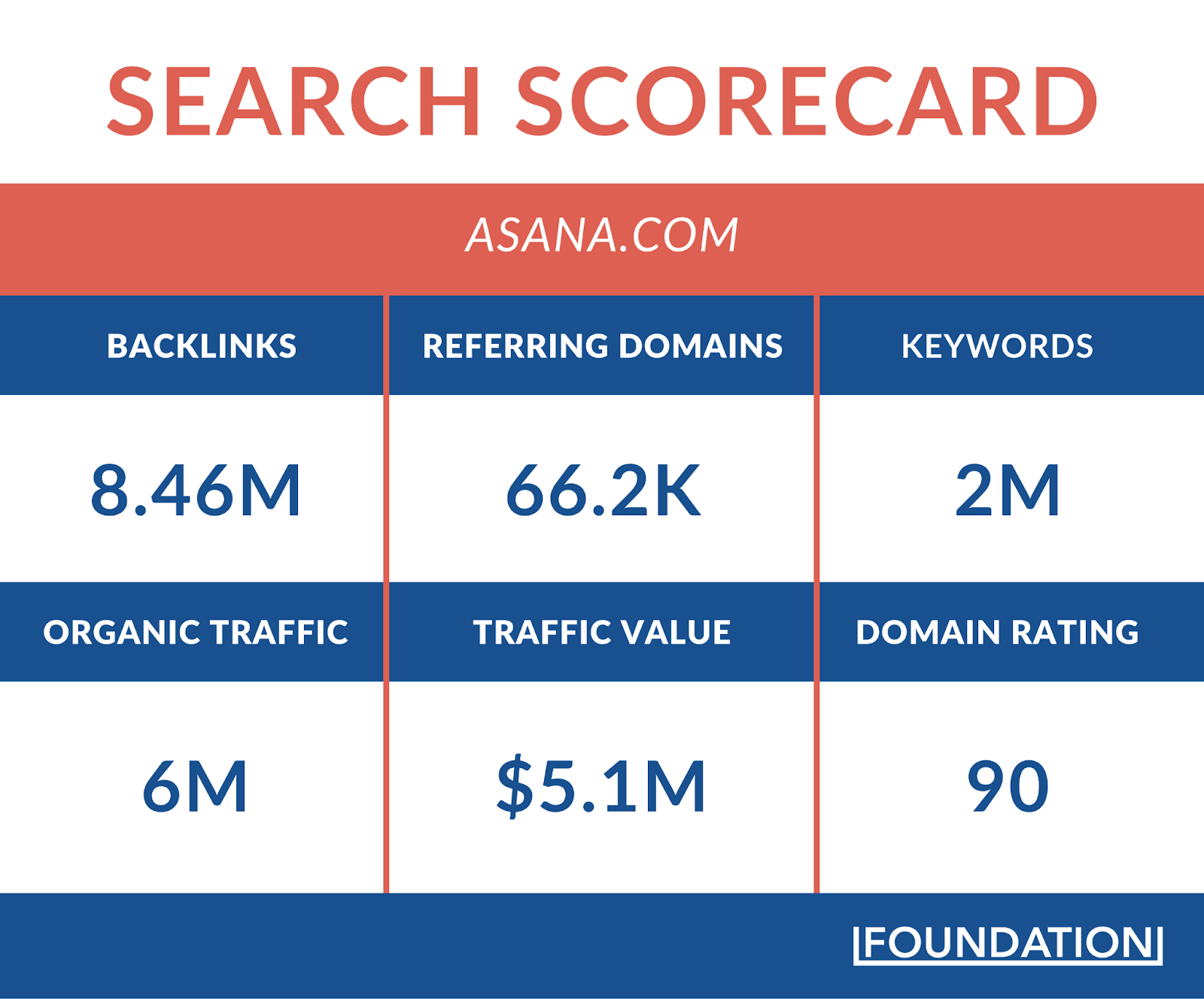
Let’s see how Asana creates TOFU content pieces, what you can learn from their strategy, and what they can do better.
How Asana Approaches TOFU Content
Top-of-the-funnel content is the resources your marketing team creates to grab the attention of your target audience, who may not know about your product. Its goal is to:
- Educate the reader about the topic
- Address common questions or pain points they have
- Make them aware of how your product can help
- Build trust and turn visitors into qualified leads
Asana uses various types of TOFU content formats to attract visitors in the early stages of their buyer journey, including in-depth beginner how-to guides. However, instead of optimizing for search intent alone, Asana uses multilingual SEO to reach and connect with a global audience that speaks different languages.
Here’s why this strategy makes sense for Asana:
Almost 20% of Asana’s visitors come from Mexico. That’s more than 1 million monthly site visits from organic traffic. The US is the second largest traffic driver for Asana.
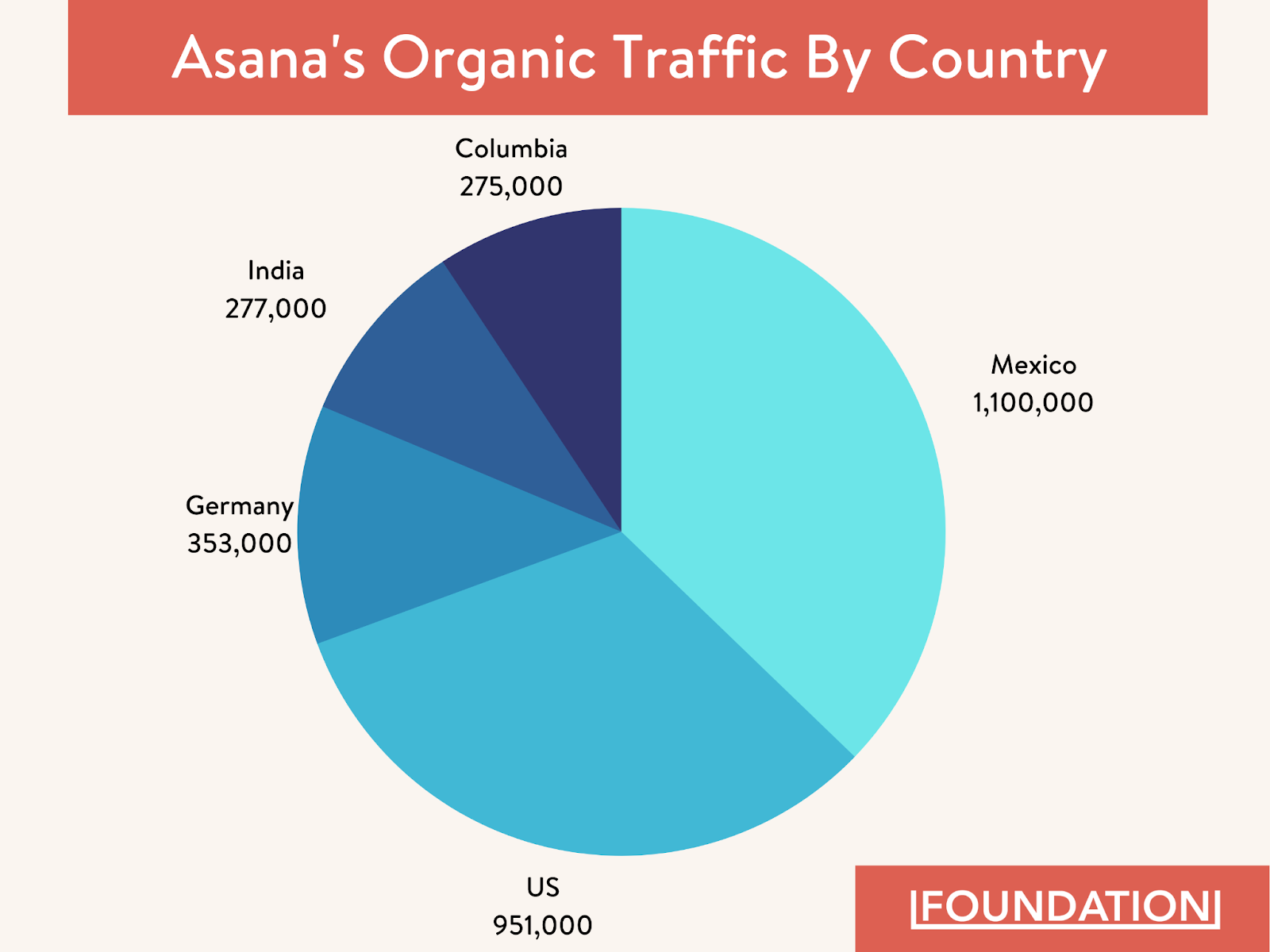
So, if someone is searching for “project management software” in English, they can easily find Asana among the top solutions on Google:
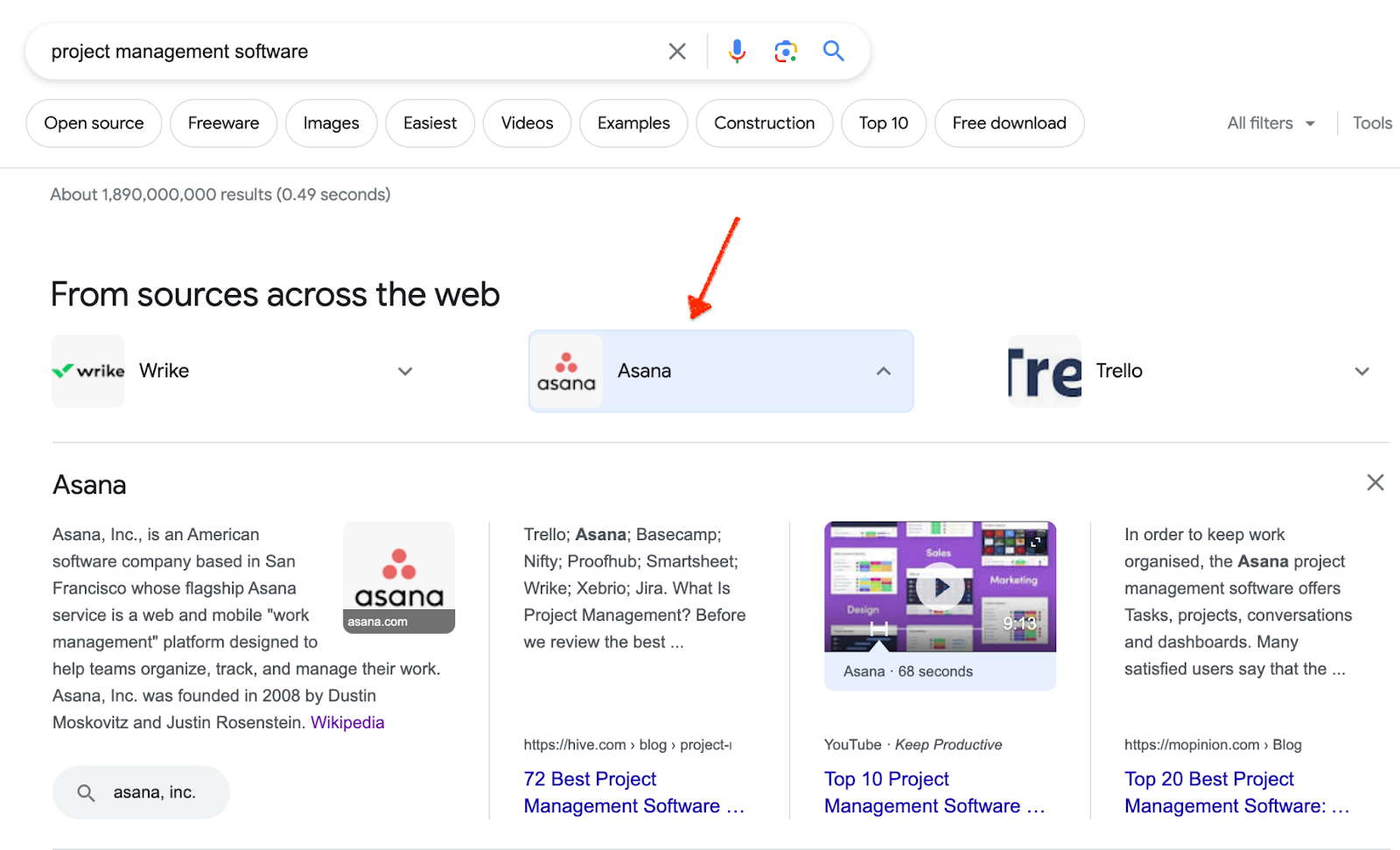
And someone searching for the same thing in Spanish, using the term “software de gestión de proyectos,” will still find Asana ranking on the first page because its website is optimized for Spanish users.

Not everyone speaks the same language or uses the same search terms on the internet. If your website is only in one language, you’ll miss out on potential customers who use different languages to search for what you offer.
Imagine if Asana only had content in English on their website. They would miss out on potential customers who prefer to search for information in their native language. Spanish users make up nearly half of their web visitors; maybe more, including those based in the US.
Implementing multilingual SEO helps you optimize your site’s content to appear in search results for different languages. It increases your chances of being discovered by people who speak those languages and are searching for products like yours.
Plus, multilingual SEO helps you build trust and credibility with international customers.
When people find helpful content in their own language, it shows you understand and value their needs. As a result, they are more likely to engage with your site, sign up for a trial, and ultimately become paying customers.
You can implement multilingual SEO by doing these activities:
- Research to identify regions where there is demand for your product. Analyze search trends, competitors, and audience preferences in different regions.
- Translate your site’s content into the target languages, and adapt your content to the cultural and linguistic nuances of each target market.
- Use tools like Ahrefs to perform keyword research in each target language to identify relevant search terms and phrases potential customers are using.
- Optimize your website’s meta tags, headings, URLs, and image alt texts in each language to make them search engine-friendly.
- Ensure that your multilingual content is easily accessible, properly indexed, and categorized on your website.
- Build backlinks from reputable websites in each target language to boost your SEO rankings. You can collaborate with local influencers, guest post on relevant blogs, or partner with industry associations in different regions to gain exposure and increase your website’s authority.
- Implement hreflang tags to signal to search engines which language versions of your website correspond to specific countries or regions, so search engines can deliver content to your audience in the correct language.
- Create valuable and engaging content tailored to the preferences and interests of your target audience in different regions to attract and engage them.
Asana’s Multilingual TOFU Content
Asana also uses this strategy for its TOFU content. Its Spanish blog, for example, drives 2,000,000 monthly organic sessions. The top four blog posts are all TOFU content dominating the SERP for high-value keywords.
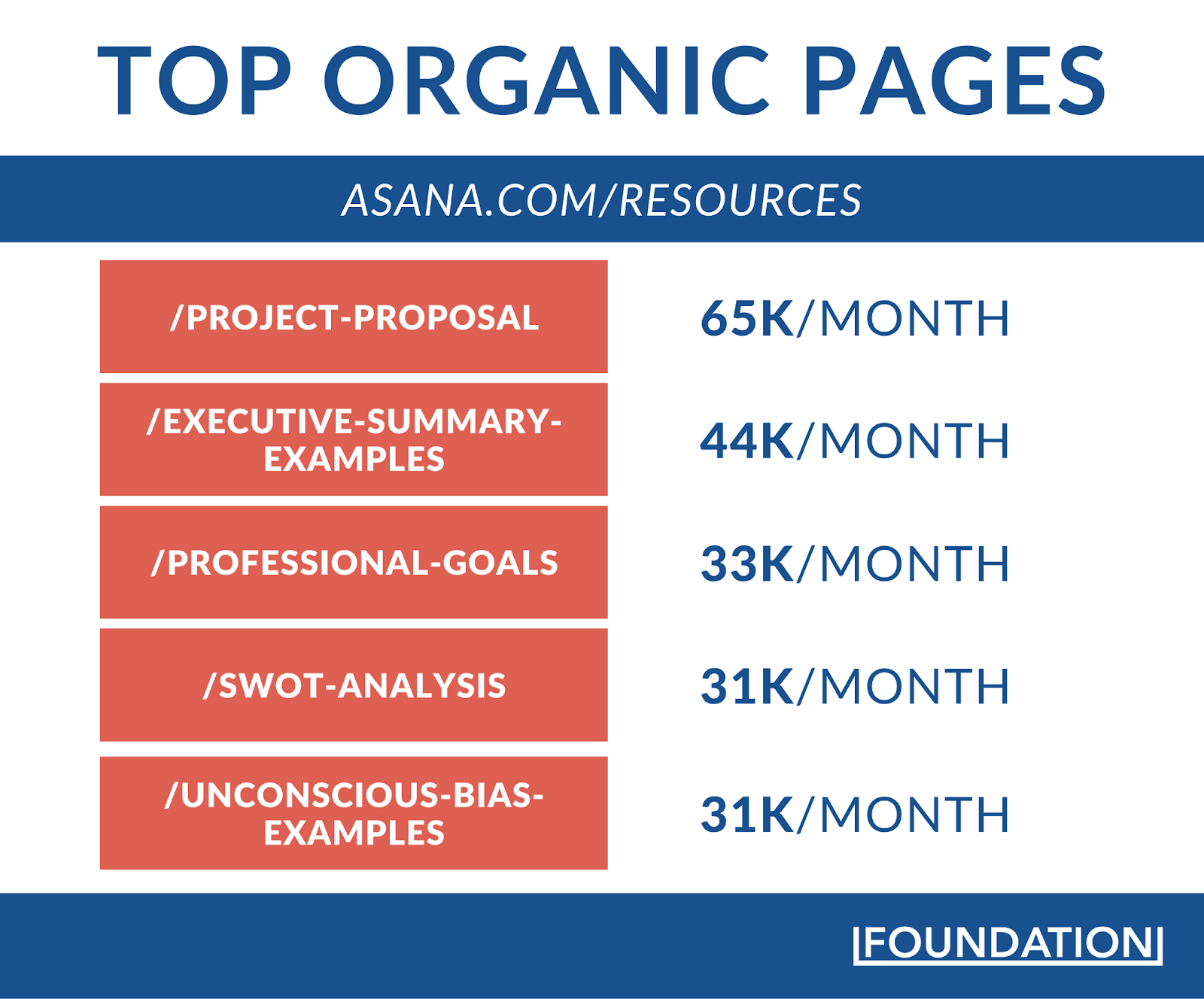
What’s most interesting is that none of Asana’s competitors rank for any of these keywords. Trello, for example, has an estimated 14,000 organic sessions every month from its Spanish blog. That’s way less than Asana’s.
Both blogs rank for the keyword “estilos de comunicación,” which has a search volume of 1,900. Asana owns the featured snippet for the keyword, with Trello in second place.

The blog post generates a whopping 134,000 monthly organic traffic visitors for Asana and only 4,400 for Trello. That’s the power of optimizing your blog for a global audience — you outrank your competitors and capture more traffic than they would (if they aren’t paying attention).
Asana’s English blog is also doing pretty well compared to competitors like Monday.

It also ranks for 641,000 keywords, many of which are TOFU. Here are its top five pages:

These blog posts have one thing in common: They are all beginner ultimate guides that break down complex topics into easy explanations and steps.
Several elements make this post stand out. First, it has a TL;DR section — a concise summary of the main points or key takeaways from a piece of content.

A TL;DR section lets your readers quickly grasp the main ideas of a lengthy or complex piece of content without having to read the entire thing. This is great for skimmers and busy professionals.
Asana also has a static side menu with jump links, which makes it easy for visitors to quickly read sections that matter most to them or move back and forth in the piece however they want to.

Asana also covers common questions the reader has on the topic and visuals that neatly summarize different sections of the blog.
Here are some tips to keep in mind to create better TOFU content:
- Identify the different search intents or common questions your target audience may have at the top of the funnel. Then create content that directly addresses those intents and provides the information they need.
- Offer practical tips, insights, or guides to help your audience solve problems or learn something new.
- Use language that sparks curiosity, promises benefits, or poses thought-provoking questions in your headlines to entice readers to click and engage with your content.
- Use visuals such as images, infographics, videos, or interactive elements to break up text and make your content more appealing.
- Conduct keyword research and optimize your TOFU content for relevant keywords and phrases. Use proper headings, meta tags, and descriptive URLs to make your content more search engine-friendly.
- Make it easy for readers to share your TOFU content on social media platforms by including social sharing buttons.
- Include relevant CTAs that encourage readers to take the next step in their buyer journey.
- Continuously analyze the performance of your TOFU content to identify what is resonating with your audience.
What Asana Can Do Better: Product-led Content
While I admire Asana’s TOFU library, especially because of the amazing results the company has produced for the brand, there’s always an opportunity to grow. I observed Asana’s content isn’t exactly product-led, despite the company’s PLG reputation.
Dr Fio Dossetto, Senior B2B content manager and editor, defines product-led content as any type of content that strategically weaves a product into the narrative and uses it to illustrate a point, solve a problem, and/or help the audience accomplish a goal.
Asana does justice to every topic it touches; however, it doesn’t strategically weave its product into the narrative — it’s only mentioned casually in the conclusion like this:

Or sometimes, the company plugs it in using an image and CTA button like this:
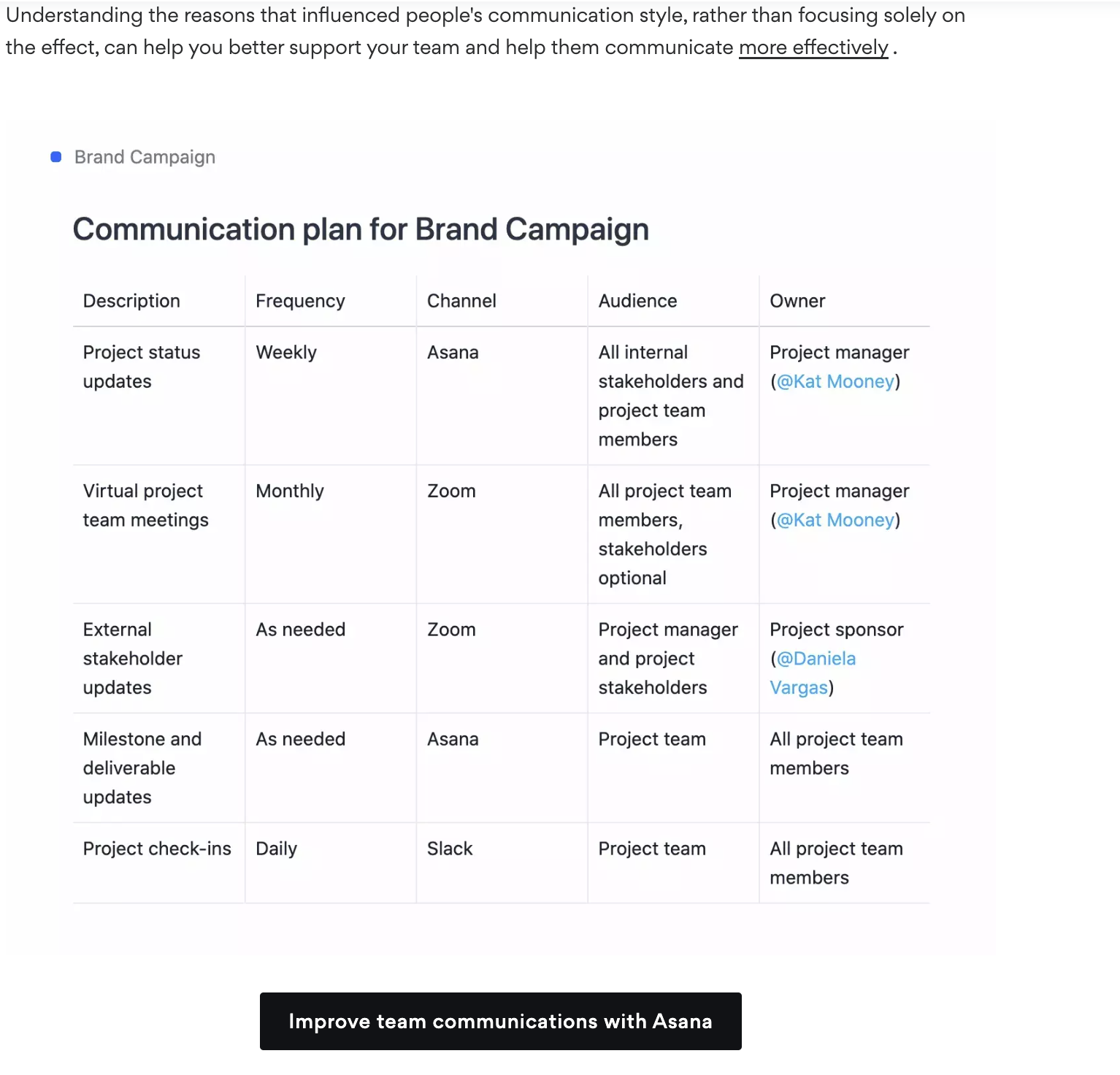
While this looks good, the issue here is that the preceding text before the image doesn’t tell any story that directly links to the image or CTA button.
So, as a prospect or visitor who is looking to see Asana in action, I will gain more value from the post if Asana breaks down how using the product will help my team communicate better. I mean, the post is great as is, but showing the product in action will make it even better.
Product-led content lets you demonstrate what your product does and how it can solve specific problems — you show potential customers how specific features can benefit them. It’s like letting someone see and try a sample of a new ice cream flavor before they decide to buy a whole scoop.
For example, Webflow does a great job of showing its product in action, especially with content pieces most users would naturally seek out. An example is the top-of-the-funnel piece, “23 best small business website examples and designs”:
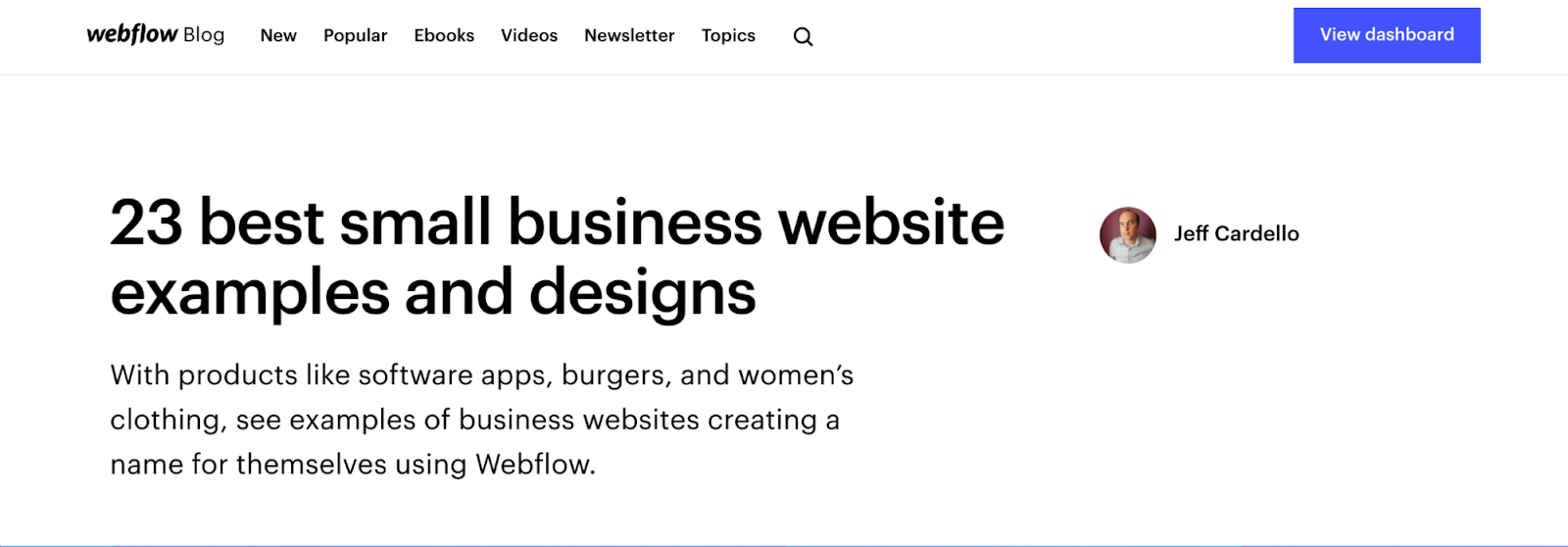
This blog post shows 23 different websites built using Webflow:
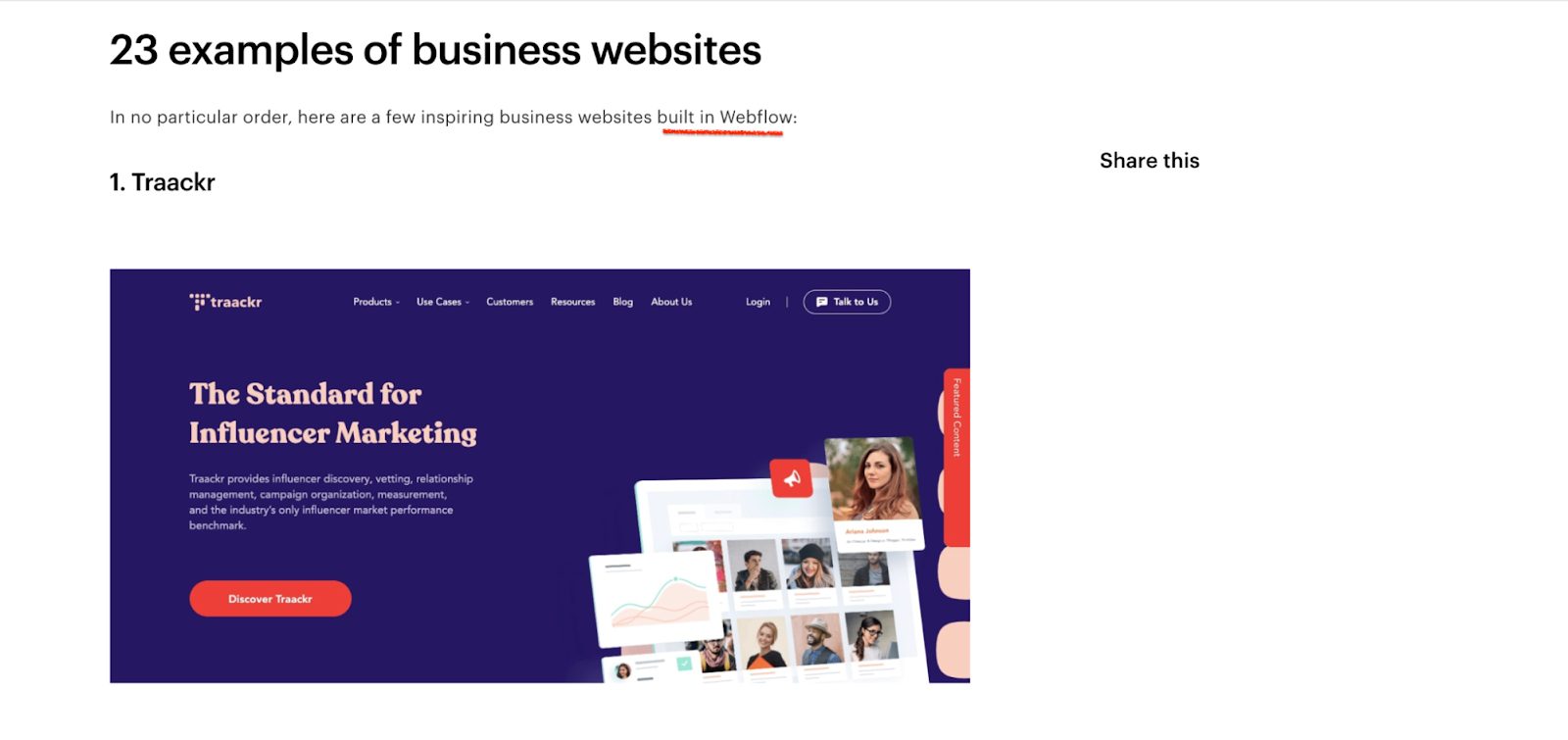
For each example, the writer links to the website in question, giving the reader a chance to see the great things they can do with Webflow.
The page ranks on the first page of Google for the query “website examples,” attracting almost 2,000 visitors every month, and it generates an organic revenue of $10,000/month. The number isn’t much compared to Asana’s success, but it’s great to see how profitable showing your tool in action can be, even at the top of the funnel. It shortens the sales cycle and gives you a chance to convert visitors from a single piece.
Ahrefs, Hotjar, and Loom are examples of brandss that take a product-led content approach. You’ll learn a lot reading about how they do this (we have full case studies on two of these tools — I linked to the case studies,, so you should check them out).
You can show your product in action by sharing practical examples or use cases to demonstrate how your product can be applied in real-world scenarios. Describe the specific benefits and outcomes users can expect to help readers visualize how your product can address their own needs.
Break down the topic into clear and actionable steps, explaining how to use your product to solve a specific problem, using screenshots, videos, and GIFs to visually guide readers through the process.
You can also incorporate testimonials or quotes from satisfied customers who have used your product to solve their problems. Include their experiences and results to add credibility and demonstrate the effectiveness of your product.
Show Your Product in Action, Even at the Top of the Funnel
Visual content is more engaging and memorable than plain text.
When potential customers see your product in action, they better understand its value and imagine how it could benefit them. This can, in turn, create an emotional connection and keep your product top of mind as they move further down the funnel.
Plus, your readers can determine if it meets their needs or if they should explore other options. This is great because it saves you and the reader time, so you can focus on qualified leads who have a genuine interest in your product.







